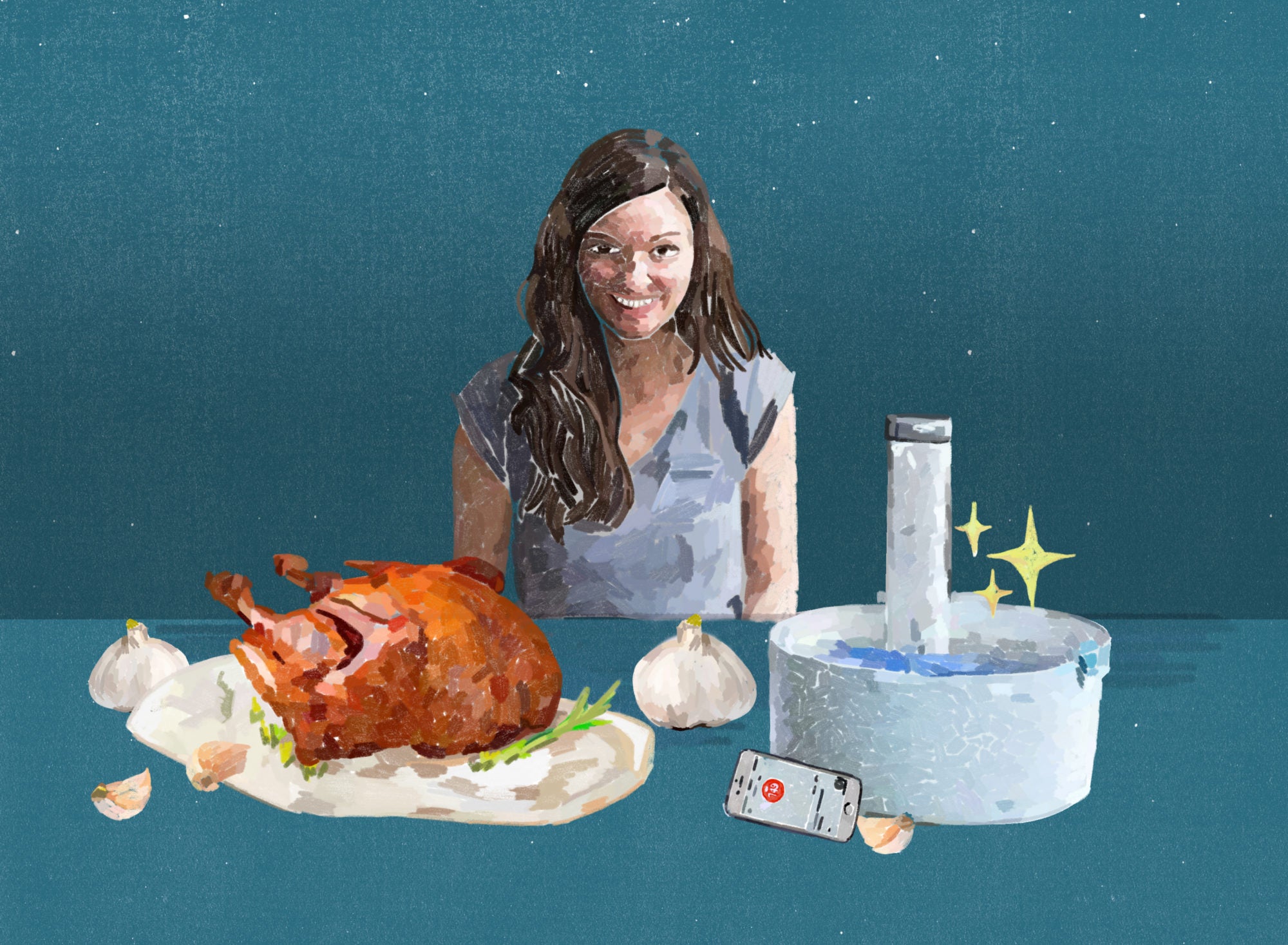
We don’t use the word “genius” lightly, but Kristen Miglore, the creative director at Food52, has definitely earned that title. As the author of Genius Recipes and Genius Desserts, she’s always looking for delightfully unexpected cooking tricks, like a brilliant three-ingredient cookie or no-knead bread. We gave her a Joule from ChefSteps and a mission: Sous vide a Thanksgiving turkey, have fun, and write down everything in a journal.
Sunday late morning: I do some rough time-lining and realize I should start cooking in the evening so that I can finish my turkey off for dinner Monday night. I’m following the ChefSteps comprehensive turkey guide and using a recipe adapted slightly from Torrisi Italian Specialties in New York. It’s their famous roasted–garlic-smothered turkey breast, which uses a low-temperature technique in the oven to avoid the pitfalls of overcooked, dry white meat. The methods are similar in spirit, if not in equipment, so I’m curious how it will go when the oven is out of the equation.
8 p.m.: My apartment smells outstanding as I roast eight heads of garlic in the oven at 375°F. After about an hour, they’re golden and nicely squishy.
9:30 p.m.: I start breaking down my turkey into two legs and two breasts. Unless you are passionate about butchering, get your butcher to do this. You’re already earning enough cool points for sous viding your Thanksgiving dinner. Be sure to ask them for the carcass, too, since you’ll want it for making stock.
10 p.m.: I nestle the carcass, plus the wing tips, some fresh thyme, a halved, unpeeled onion, and some peppercorns into a Dutch oven for the stock, top it off with water, cover the pot, and plunk it into a 225°F oven overnight. The fact that you can make this stock ahead for gravy and stuffing and not worry about babysitting it on the stovetop is pretty incredible.
I squeeze all my cooled, sticky roasted garlic out of its skin and blend it with a couple tablespoons of honey in a mini food processor, then rub the paste under the turkey’s skin before I do the pre-searing step. I don’t want any of this sneaking out into the pan and burning, so I squeegee any excess out.
These seared turkey quarters are heavy and slippery, and trickier to maneuver than I thought. As I’m balancing a sheet pan with three of my lovely seared pieces of turkey on the stove and trying to add the fourth, the pan upends onto the floor. With Julia Child in my head, I decide to wipe them off and press on. I pile them back on the tray, go to pinch the last leg from the pan, and it slips from the tongs and bounces right onto the floor. This is why you should do what ChefSteps says and use a clean kitchen towel to move your pieces of turkey around—you’ll have much better control and less slapstick.

Finally, it’s time to sprinkle some salt and sugar over the turkey for the brine. The breasts and legs go into their own two-gallon ziplock-style baggies I picked up at my bodega. The leg baggie gets the Joule treatment first, while the breasts wait their turn in the fridge overnight.
11:45 p.m.: Legs are garlicked, seared, salted, and in their baggie hanging out in a nice Joule jacuzzi bath at 150°F for the next 12 or so hours. For a person who just dropped four turkey limbs on the floor, setting up the app to get the Joule going is pretty seamless. It’s a matter of downloading the app, plugging in the Joule and setting it in a pot of water, then picking a temperature. The Joule starts circulating the water to heat it quickly, sounding like a soothing water fountain at the dentist’s office, and my new friend the app notes exactly when I started cooking so I won’t forget.
Monday
8:30ish: Before I head to work, I turn down the Joule’s heat to 131°F and drop in my baggie of seared, seasoned breasts that have been patiently waiting in the fridge. My 5.75-quart Dutch oven is pretty snug (a big stock pot or deep roasting pan would have been better), so to free up a little room, I try to drain some of the cooking juices from the leg bag and save them for the gravy, and one last leg slides out onto the floor.
I check on my oven stock, and see that the liquid level has barely changed even though the stock is a gorgeous rich brown. I don’t have time to strain the stock before work, so I opt to leave it in the oven longer. This stuff will be ramen-worthy.
9:30 p.m.: I get home, take out the breasts and legs, and dry them off to ready them for their final sear. I blanch some green beans and, in the same pot, boil some potatoes for mash. I sear the breasts and broil the legs to crisp them up—it’s amazing how lovely and even the second sear turns out, thanks to the pre-sear. Even though there’s no roasting pan of drippings for gravy, I have the skillet from searing as a base plus some extra butter—adding in some flour for a roux and that gorgeous oven stock, I have everything I need to throw together a quick gravy. Nothing else drops on the floor! Mini Thanksgiving dinner, done.
Final Thoughts:
Compared to the more traditionally roasted turkeys I’ve loved (Russ Parsons’s dry-brined Judy Bird and Barbara Kafka’s high-heat method), this is the only one that can take care of itself while I’m off doing other things all day. And compared to other make-ahead turkeys I’ve tried, this one was more controllable and hands-off, too. And none of them except the sous vide version leave the oven free for apple pies and stuffing and various casseroles the whole dang time.
This article was produced in partnership with ChefSteps.
